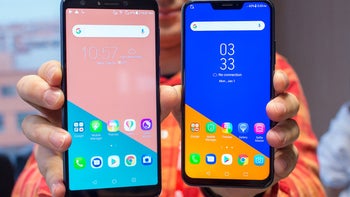Asus ZenFone 5 and ZenFone 5Q hands-on: hey there, good-looking!

Mobile World Congress is in full swing in Barcelona, and announcements have been pouring over the past few days. The latest unveiling comes from Asus: the company just introduced a trio of new ZenFone 5 handsets, including the Asus ZenFone 5Z flagship. However, the first two phones we had the chance to check out were the ZenFone 5 and ZenFone 5Q – and at a glance, they don't look bad at all. (In a last-minute update, Asus informed us that the ZenFone 5Q will be known as ZenFone 5 Lite outside of the US.)

Actually, calling the ZenFone 5 and 5Q "not bad" would be an understatement. The two are quite attractive with their design and would definitely stand out in their price point. This is especially true for the Asus ZenFone 5, the design of which bears a striking similarity to the iPhone X. Yup, the phone has a notch – that is where its front-facing cam resides, alongside various sensors. The spacious display (19:9 ratio, 6.2 inches) exhibits bold and vivid colors, and even if its color accuracy isn't perfect, we must stay that it looks pretty good to the naked eye. The ZenFone 5 Lite has an extra-tall display as well (6-inches in diagonal), but lacks a notch, while colors appeared noticeably tamer and blueish. Needless to say, the two ZenFone models are quite big physically, though not impossible to handle.
Flipping the two phones around we find dual cameras on both, as well as center-positioned fingerprint scanners. Face Unlock is also available on both. The back itself is made of glass, and while it is a fingerprint magnet, it does reflect light in a rather unique manner when it's clean.
ZenUI, Asus's custom Android interface, is found on both phones, but only the ZenFone 5 appears to have been enhanced with AI features. While the term appears to have been used quite broadly here, the features that it enables sound neat. AI Display, for instance, adjusts the screen's color temperature to the environment and disables the screen timeout if it detects that you're still using the phone. AI Battery prolongs the battery's lifespan by limiting overnight charges to 80% capacity, then fills up the rest in the morning right before you wake up. AI Ringtone adjusts the volume of the ringtone depending on the environment. And the camera is made to recognize a number of scenes, helping you take better photos.
Now that we've mentioned it, we have dual main cameras on the ZenFone 5 and 5 Lite. The setup is comprised of a regular main camera and a wide-angle secondary shooter. Both can take portrait shots with background blur – with their main and front cameras, too! But only the ZenFone 5 Lite has dual cameras at the front. The secondary cam in this case is again a wide-angled one for those group selfies.
As mentioned, the ZenFone 5 can recognize various scenes, which could be helpful in tricky situations. Winter scenes are a good example where scene recognition comes in handy, as the ZenFone 5 could adjust color accordingly to not produce an overly blueish snowy scene. Asus's algorithms control not only the way colors look, but also aspects like exposure, sharpness, and noise.
Sound on the ZenFone 5 is produced by a stereo speaker arrangement. During a quick demonstration, the phone was compared against a Galaxy S8 and a Google Pixel 2 XL, and yes, it did sound louder. Overall sound quality could have been better, though.
Ultimately, Asus would never claim that the ZenFone 5 and ZenFone 5 Lite are the best phones on the market. On the other hand, they could be among the better options in their respective price segments, judging by what we saw during our brief time with the two. We doubt that the AI features would draw a lot of buyers, however. The ZenFone 5 and 5 Lite have a better chance at attracting attention with the way they look, especially when put side by side with similarly priced devices.













Things that are NOT allowed: